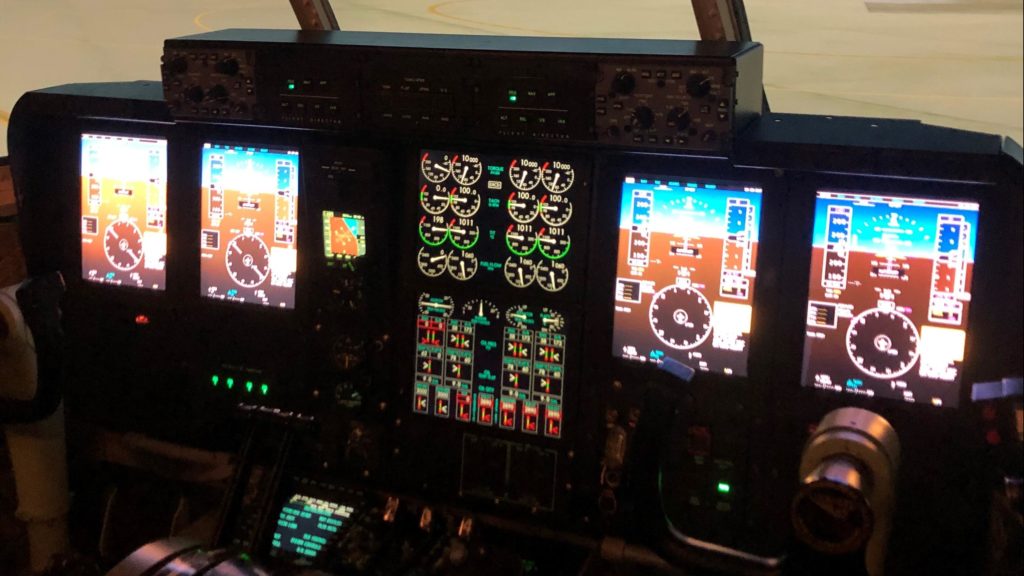
The view from one of the GoPro cameras installed in the C-130T Avionics Obsolescence Upgrade Operational Flight Trainer. The cameras allowed remote observation of live software tests in Fort Worth by engineers in Maryland, New York, and North Carolina over a two-day period last month. Photo: U.S. Navy
Due to travel restrictions because of COVID-19, the Navy and Lockheed Martin remotely tested software fixes for the latest software build of the C/KC-130T Avionics Obsolescence Upgrade (AOU) program in Fort Worth last month, the service said.
The two-day testing on Apr. 7 and 8 used the Maryland-based J.F. Taylor, Inc.’s modification of the legacy 2F-152 AOU Operational Flight Trainer (OFT) at the Air Logistics Training Center at Naval Air Station (NAS) Fort Worth Joint Reserve Base, Texas. J.F. Taylor received contracts worth about $7 million for the modification of OFT to the AOU configuration–work which the Navy said finished in January last year.
“Accomplishment of the two-day remote assessment was critical for determining if the software fixes a number of high-priority deficiencies that affected certifications required by the Department of Defense and Federal Aviation Administration,” the Navy said. “The proactive identification of content problems prior to the delivery of the final software in June and flight tests during the summer decreases the risk of program delays down the line.”
In a May 5 email to Avionics International, the Naval Air Systems Command’s (NAVAIR) tactical airlift program office (PMA-207) at Naval Air Station (NAS) Patuxent River, Md. said that the “software configuration release addressed outstanding watch items to support NAVAIR submission for full RNP/RNAV [Required Navigation Performance/Area Navigation] certification for C/KC-130T aircraft commonly discovered during flight test.”
Lockheed Martin is using its Common Open Reuse Environment (CORE) cockpit for AOU. The company has said that CORE is the “first fully ‘app-based’ cockpit solution designed in alignment with the [DoD] Future Airborne Capabilities Environment (FACETM) standard.” The Bell V-280 Valor tiltrotor also uses the CORE cockpit. In March, the U.S. Army selected the V-280 Valor and the Sikorsky-Boeing SB-1 Defiant to move forward in the Future Long- Range Assault Aircraft (FLRAA) competition.
Under AOU, the Navy plans to upgrade 25 of the C/KC-130T aircraft. Congress has appropriated about $163 million for the program thus far, including about $13.7 million in fiscal 2019 and $22.7 million in fiscal 2020. The Navy’s fiscal 2021 budget requests $21.5 million for AOU in fiscal 2021.

A GoPro camera installed in the cockpit of the C-130T Avionics Obsolescence Upgrade Operational Flight Trainer at Naval Air Station Fort Worth Joint Reserve Base allowed teams in four separate locations around the country to observe a software test while adhering to COVID-19 restrictions. Photo: U.S. Navy
Under AOU, Lockheed Martin is to replace “obsolete flight control displays, radios, and transmitters, with digital multi-function displays [MFD] and navigation, surveillance, and cockpit voice/data recorder equipment that will allow the aircraft to continue operating safely in the modern air traffic control environment,” according to the Navy. “Test completion of the AOU system is expected in fall 2021.”
In its email to Avionics, PMA-207 said that “AOU is a government Lead System Integration (LSI) program.”
“The AOU flight control display design, layout, architecture, and integration is completed organically,” according to PMA-207. “Radios and transmitters were procured through the NAVAIR Common Avionics Program Office. Digital multi-function displays were procured from Lockheed Martin. Navigation, surveillance, and cockpit voice/data recorder equipment were procured from multiple simplified acquisition contracts with Original Equipment Manufacturers.”
To allow the software tests last month in Ft. Worth to be observed by engineers in Lockheed Martin’s Owego, N.Y. facility, NAS Patuxent River, Md. and Naval Air Warfare Center Training Systems Division in North Carolina, the Navy used two GoPro cameras in the simulator cockpit in Ft. Worth to provide live feeds of the cockpit MFDs and the control display units.
“Using the live feeds, the engineering and test teams were able to direct Fleet Logistics Support Wing C-130 pilot Cmdr. Patrick Foreman in the execution of test cards prepared by VX-20 [at NAS Patuxent River],” the Navy said. “Although Cmdr. Foreman had only limited experience with the AOU program, the real-time guidance from the test team allowed him to easily complete the test points and provide thorough feedback on the results. The presence of the Lockheed Martin engineers enabled the team to troubleshoot and discuss test results as they happened, saving many hours that would have otherwise been spent documenting and conveying test results to the contractor.”
The Naval Reserve has 19 C-130Ts, which entered service in 1991, and VX-20 has six KC-130Ts, which achieved initial operational capability in 1983.
The Lockheed Martin KC-130J is to replace the C/KC-130Ts, which are to retire by 2033. The C/KC-130Ts are the Navy’s only cargo plane capable of moving oversized cargo, such as missiles, submarine masts, and fully-intact engines for the Lockheed Martin F-35 Lightning II fighter.
“Ultimately, a transition from the aging C/KC-130T to the C-130J is necessary to ensure interoperability and
capitalize on the existing supply chain for these more modern aircraft,” Vice Adm. Luke McCollum, the chief of the Navy Reserve, told the Senate Appropriations Committee’s defense panel on March 4.